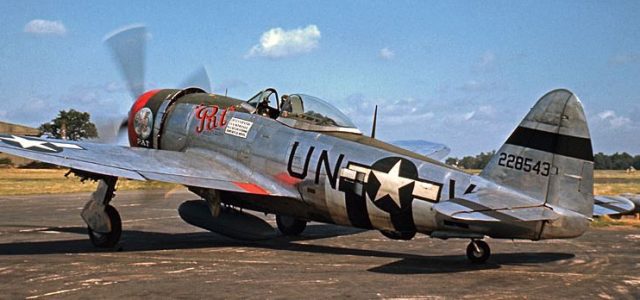From its inception, the 56th was destined for excellence and historical significance. As the first fighter group to be challenged, and possibly intimidated, by Republic’s new radial-engined beast, the group took on that mission and remained faithful to its charge till the end of hostilities.
As part of a pre-war build-up of 35 Army Air Forces combat groups, the 56th Pursuit Group was activated on paper in January 1941, initially at Savannah, Georgia, then activated in Charlotte, North Carolina, in late May after the first flight of the XP-47B. Training of the group’s three squadrons (61st, 62nd, and 63rd) was accomplished with weary P-36 and early P-39s as the 56th worked up to effectiveness with war games exercises and then on East Coast anti-sub patrols after the Pearl Harbor attack. In January 1942, the group was scattered around the New Jersey and New York City area with one squadron based by the Republic Farmingdale factory on Long Island. While Republic was ramping up P-47 production, the group trained in a few newly arrived P-38Es with expectations that they would take Lightnings into service. But Lockheed production delays laid fortune upon the 56th when the 63rd Squadron received the first production B model Thunderbolts.
Wrestling the type to combat effectiveness, the group soon confronted the compressibility boundary and identified other needed improvements that were soon incorporated into the C model. In January of 1943, orders embarked the 56th, with its service group, aboard the liner Queen Elizabeth. Initially based at Kings Cliffe in April, the 56th moved to better accommodations at RAF Horsham St Faith, near Norwich.
Early problems with the new HF radios delayed operations until April 8, when the Thunderbolts began high-altitude “Rodeo” sweeps over the French coast with the 4th and 78th Groups. Under the seasoned leadership of Col. “Hub” Zemke the 56th expanded its operating area adding fuel-limiting bomber escort (Ramrod) missions with the developing Eighth Air Force. Over the next year, fighter tactics evolved that, with added external tanks, allowed penetrations to the German border. In mix-ups with the Luftwaffe, “Zemke’s Wolfpack” concentrated on dive and recovery-style attacks. The group made two moves in that period, initially to the undesired Halesworth, Suffolk, and finally to Boxted in April 1944.
With the lifting of ground strafing prohibition by General James Doolittle in February 1944, the 56th embarked on a more perilous phase of endeavor that affected several of their key pilots with shoot down and internments. D-Day and the following period saw the group hang on to its trusted mounts as other P-47 groups transitioned to the Mustang for long-range escort.
The late advent of the high-performance P-47M in January 1945, exclusively to the 56th, presaged a return to its previous Ramrod role but teething problems with the engine’s manufacture limited their effect. By then, a neutered Luftwaffe relegated the group to strafing out the war, although some jet kills were made in April. All told, the 56th was credited with 664 aerial kills, leading all ETO units, and ensuring it place in the annals of military aviation history. -By Stan Piet
















